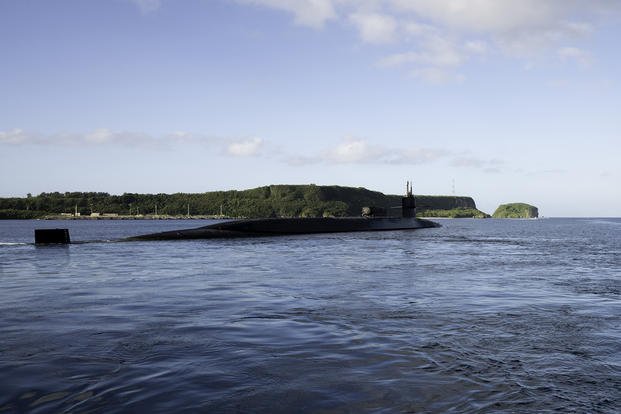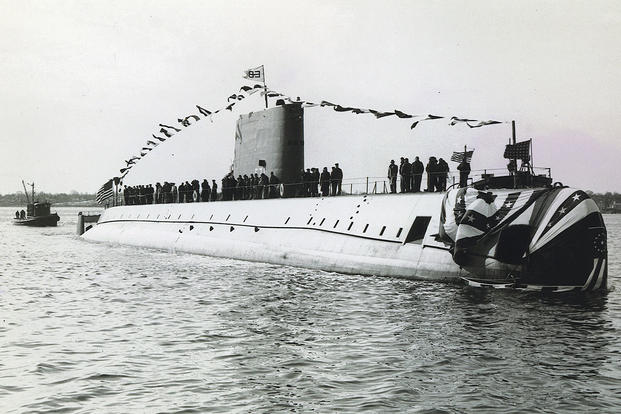In the years after World War II, the U.S. Navy found itself with an aging fleet of diesel submarines ill-equipped to deal with the new rules of a new type of war, the Cold War.
This new faceoff with the Soviet Union emphasized espionage over confrontation, and electronic warfare over a torpedo shot. In secrecy and stealth, the submarine became the sentinel and remained vigilant for any rumbling of the Soviet bear.
By the early 1950s, the application of nuclear propulsion to submarine warfare changed the face of the Cold War. Under the auspices of Rear Adm. Hyman Rickover, the father of nuclear submarines, the USS Nautilus, launched in 1954, became the world's first nuclear-powered submarine.
In 1955, the Nautilus' maiden journey took her from the Electric Boat Yards in New London, Connecticut, to San Juan, Puerto Rico. The trip covered 1,350 miles in 84 hours, submerged. Her reactor gave the Nautilus nearly unlimited range and a submerged cruising speed of 20 knots. In August 1958, she became the first submarine to travel under the arctic pack ice from Point Barrow, Alaska, to Spitsbergen, Norway.
The Navy immediately recognized the importance of building a nuclear fleet, and research and design continued. In 1956, the USS Skipjack was launched with a dirigible-type hull and a single propeller.
The new Thresher class entered the fleet in the early 1960s. The loss of the USS Thresher on April 10, 1963, off the coast of New England, the first loss of an American nuclear submarine, caused the Navy to reevaluate its training and development of DSRV's (deep submergence rescue vehicles). All 129 crew on board went down with the ship.
The next step in the evolution of the nuclear submarine, the advent of the submarine launched nuclear missiles, also came in the early 1960s with submarines carrying the Polaris missile. These Polaris subs had a strike range of nearly 2,500 miles and launched while submerged. In the mid-1960s, a further step was made in the development of long-range antisubmarine missiles launched from torpedo tubes.
In the late 1960s, the newer long-range, sea-launched ballistic missile (SLBM) Poseidon missile replaced the Polaris missiles on some submarines. These missiles increased the lethality of the nuclear submarine by carrying 10 nuclear warheads. The Polaris paved the way for the development of the Trident system in the early 1970s. This successor to the Polaris-Poseidon included the new Ohio class of nuclear submarine, the first vessel of which, the USS Ohio, was launched and commissioned in 1981.
By 1988, the United States had 132 submarines in operation, including attack and ballistic missile submarines. The range of maneuver on these submarine reactors provided propulsion for approximately 400,000 miles without refueling the nuclear core. Conversely, the arms race of the Cold War built the Soviet navy to an estimated 120 nuclear submarines; 48 of these equipped with cruise missiles, the remainder with guided antisubmarine missiles.

Ohio-class submarines carry 24 Trident I or Trident II SLBMs in their launching tubes. The Trident II is a three-stage, solid propellant, inertially, guided missile, with a range of more than 4,600 miles.
Since the fall of the Soviet Union, there are presently 18 ballistic nuclear submarines in the U.S. Navy. These "boomers" remain a lethal leg of the United States nuclear triad, due to their mobility and stealth. All 18 submarines are of the Ohio class, armed with long-range ballistic missiles containing 3,500 nuclear warheads.
Split between the Atlantic and Pacific, 10 of the Tridents are based at Kings Bay Submarine Base, Georgia, and the remaining eight at Naval Submarine Base Bangor, Washington. Between eight and 11 of these silent harbingers of death are on patrol beneath the waves at any given time. They have two alternating crews, the "Blue" and the "Gold," to allow the Tridents the maximum amount of time on patrol.
Cruises normally last six months, and the days are filled with missile drills and simulated strike operations to keep the crews at a high state of operational readiness. This operational tempo does not slack while in port. Stringent inspections of the port facilities, as well as the crews and sub, take place at least every 18 months in order to ensure they are capable of carrying out their assigned nuclear functions.
Since 1990, the U.S. submarine fleet has shrunk by 40%. There are 56 fast-attack subs, down from a high of 103, and 18 boomers, down from 36.
With further reductions on the sub fleet projected, the total number of Tridents will drop to 14 by 2003.
Factions in the Navy argue that these cuts have gone too deep, and while the submarine fleet has been bled white in force reduction cutbacks, the amount of time the remaining boats spend on attack, espionage and reconnaissance missions has doubled.
With fewer and fewer Russian submarines prowling the seas, there are still more than 600 submarines down in the briny depths. Many of these are flagged under the navies of potential belligerents, such as China, North Korea and Iran.
The roles of submarines continue to evolve. In 1999, during the NATO air war over Yugoslavia, submarines launched 25% of all Tomahawk missiles, and plans have been put in motion to convert more attack submarines to this purpose.
Studies project the Navy will need at least 55 attack submarines by 2015 and 62 by 2025 to augment urgent security needs worldwide. To respond to this growing need, the Navy will extend the service lives of its aging Los Angeles-class submarines by three years to a total of 33 years. This will postpone the decommissioning of seven Los Angeles subs.
Another stopgap measure involves the conversion of four Tridents from ballistic-missile submarines into cruise-missile boats. These converted Tridents could support special operations by serving as "mother ships" for up to 66 SEALs and their mini-submarines, used in intelligence gathering and raids.
Through budgetary constraints and military downsizing, the Navy still has not lost sight of the importance of its submarine fleet. Construction at Electric Boat of Seawolf on the newest class of fast attack is underway on two new submarines, the Virginia and the USS Jimmy Carter (SSN 23). Both are scheduled for launch in 2004. When complete, the USS Jimmy Carter, named for the former president who served as a officer onboard a nuclear submarine, will be 100 feet longer than the standard 353-foot Seawolf boat. This extra space is intended to accommodate special warfare and espionage missions. Ultimately, the Navy intends to add 30 of this new class of submarine to the fleet.
Want to Know More About the Military?
Be sure to get the latest news about the U.S. military, as well as critical info about how to join and all the benefits of service. Subscribe to Military.com and receive customized updates delivered straight to your inbox.












